
Mettawa is a village in Lake County, Illinois, United States. Per the 2020 census, the population was 533. The village maintains trails for pedestrian, bicycle and equestrian usage. Five forest preserves of the Lake County Forest Preserve District are located within village boundaries.

Charles A. Lindbergh State Park is a 569-acre (2.3 km2) Minnesota state park on the outskirts of Little Falls. The park was once the farm of Congressman Charles August Lindbergh and his son Charles Lindbergh, the famous aviator. Their restored 1906 house and two other farm buildings are within the park boundaries. The house, a National Historic Landmark, and an adjacent museum are operated by the Minnesota Historical Society, known as the Charles Lindbergh House and Museum. Three buildings and three structures built by the Works Progress Administration in the 1930s were named to the National Register of Historic Places. These buildings include a picnic shelter and a water tower, built in the Rustic Style from local stone and logs, and have remained relatively unchanged since construction. Although the property includes shoreline on the Mississippi River, the Lindbergh family requested that the park not include intensive use areas for swimming or camping, so development was kept to a minimum.

Woodlawn is a historic house located in Fairfax County, Virginia. Originally a part of Mount Vernon, George Washington's historic plantation estate, it was subdivided in the 19th century by abolitionists to demonstrate the viability of a free labor system. The address is now 9000 Richmond Highway, Alexandria, Virginia, but due to expansion of Fort Belvoir and reconstruction of historic Route 1, access is via Woodlawn Road slightly south of Jeff Todd Way/State Route 235. The house is a designated National Historic Landmark, primarily for its association with the Washington family, but also for the role it played in the historic preservation movement. It is now a museum property owned and managed by the National Trust for Historic Preservation.
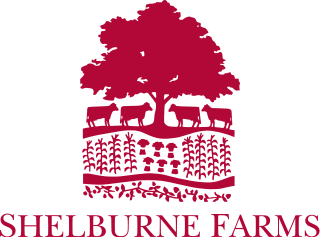
Shelburne Farms is a nonprofit education center for sustainability, 1,400 acres (570 ha) working farm, and National Historic Landmark on the shores of Lake Champlain in Shelburne, Vermont. The property is nationally significant as a well-preserved example of a Gilded Age "ornamental farm", developed in the late 19th century with architecture by Robert Henderson Robertson and landscaping by Frederick Law Olmsted.

Eagle Island is an island in Maine's Casco Bay and the site of the summer home of the polar explorer Admiral Robert Peary (1856-1920). The island and home are preserved as the Eagle Island State Historic Site
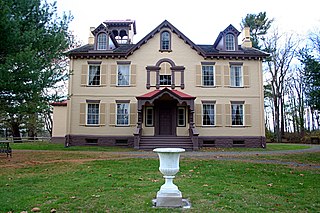
Martin Van Buren National Historic Site is a unit of the United States National Park Service in Columbia County, New York, 1 mile (1.6 km) south of the village of Kinderhook, 125 miles (201 km) north of New York City and 20 miles (32 km) south of Albany. The National Historic Site preserves the Lindenwald estate owned by Martin Van Buren, the eighth president of the United States. Van Buren purchased the 36-room mansion during his presidency in 1839, and it became his home and farm from his leaving office in 1841 until his death in 1862.

Blackacre State Nature Preserve is a 271-acre (110 ha) nature preserve and historic homestead in Louisville, Kentucky. The preserve features rolling fields, streams, forests, and a homestead dating back to the 18th century. For visitors, the preserve features several farm animals including horses, goats, and cows, hiking trails, and a visitor's center in the 1844-built Presley Tyler home. Since 1981, it has been used by the Jefferson County Public Schools as the site of a continuing environmental education program. About 10,000 students visit the outdoor classroom each year.

The Santanoni Preserve was once a private estate of approximately 13,000 acres (53 km²) in the Adirondack Mountains, and now is the property of the State of New York, at Newcomb, New York.

The Stevenson House, located at 1316 E. Washington St. in Bloomington, Illinois, was the boyhood home of Illinois governor and two-time Democratic presidential nominee Adlai Stevenson II. Architect Arthur Pillsbury designed the house in 1900 for original owner Lyman Graham. In 1906, six years after Adlai's birth, the Stevenson family bought the house. Adlai lived in the house through his junior year in high school to attend University High School in nearby Normal, Illinois; he subsequently graduated from the Choate School in Connecticut. He served as governor of Illinois from 1949 to 1953, ran for president on the Democratic ticket in 1952 and 1956, and served as U.S. Ambassador to the United Nations from 1961 until his death in 1965.
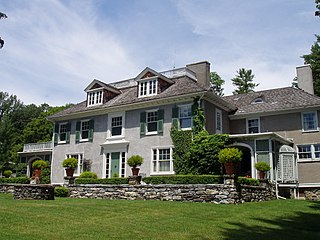
Chesterwood was the summer estate and studio of American sculptor Daniel Chester French (1850–1931) located at 4 Williamsville Road in Stockbridge, Massachusetts. Most of French's originally 150-acre (61 ha) estate is now owned by the National Trust for Historic Preservation, which operates the property as a museum and sculpture garden. The property was designated a National Historic Landmark in 1965 in recognition of French's importance in American sculpture.

Oldfields, also known as Lilly House and Gardens, is a 26-acre (11 ha) historic estate and house museum at Newfields in Indianapolis, Indiana, United States. The estate, an example of the American country house movement of the late nineteenth and early twentieth centuries, was designated a U.S. National Historic Landmark in 2003.
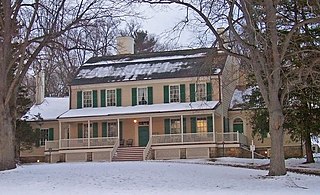
The John Jay Homestead State Historic Site is located at 400 Jay Street in Katonah, New York. The site preserves the 1787 home of Founding Father and statesman John Jay (1745–1829), one of the three authors of The Federalist Papers and the first Chief Justice of the United States. The property was designated a National Historic Landmark in 1981 for its association with Jay. The house is open year-round for tours.

The Mayslake Peabody Estate is an estate constructed as a country home for Francis Stuyvesant Peabody between 1919 and 1922. The estate is located in the western Chicago suburb of Oak Brook, Illinois, United States, and is now part of the Mayslake Forest Preserve administered by the Forest Preserve District of DuPage County.

Kennicott Grove is an area of prairie and wooded lands that includes the home of John Kennicott (1802–1863) and his family, including his son Robert Kennicott (1835–1866). John Kennicott was an agriculturalist and a doctor. Robert Kennicott was a naturalist and an explorer, who founded the Chicago Academy of Sciences. The grove is 123 acres (0.50 km2) in size. It is located near the intersection of Milwaukee Ave. and Lake Ave. in Glenview, Illinois, in the United States. Kennicott Grove was declared a National Historic Landmark in 1976. The site is maintained by the Glenview Park District as The Grove National Historic Landmark or also The Grove, and contains a nature interpretive center, historic buildings, and nature trails.

Grey Towers National Historic Site, also known as Gifford Pinchot House or The Pinchot Institute, is located just off US 6 west of Milford, Pennsylvania, in Milford Township. It is the ancestral summer home of Gifford Pinchot, first chief of the newly developed United States Forest Service (USFS) and twice elected governor of Pennsylvania.
Stevenson House may refer to:
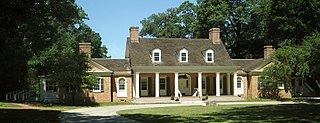
The Edward L. Ryerson Conservation Area is a protected area and historic district in Riverwoods, Illinois, United States. The area was a weekend getaway for businessman Edward L. Ryerson, who built a cabin there in 1928. He built three other cabins for friends, and had a country house built in 1942. It is representative of the type of getaways used by successful Chicagoans who sought the tranquil surroundings of the Des Plaines River. The Ryersons donated the property to the Lake County Forest Preserve district for public use. 471 acres (191 ha) are recognized as the Edward L. Ryerson Area Historic District.

The Rocks Estate, also known as the John Jacob Glessner Estate, is a historic summer estate in Bethlehem, New Hampshire. The large estate, covering more than 1,300 acres (530 ha), is located near the junction of U.S. Route 302 and Interstate 93, and includes some twenty buildings. The estate was assembled by John Jacob Glessner in the 1880s, and is one of the largest and best-preserved surviving private estates in the state. Glessner created The Rocks as a private conservation initiative, to prevent destructive farming methods from destroying the land.

The Princeton Ice Company built a dam in 1884 on former farmland so as to allow for the production of ice for sale to residents and businesses in Princeton, New Jersey. This company was the primary supplier of ice to the town during the era of the frozen water trade before the advent of artificial refrigeration. In 1902 a second dam was added so as to increase ice production capacity. The company dissolved itself in 1929, after technological change rendered the ice trade obsolete. The nearly 77 acres (31 ha) site has gone undisturbed in the decades since, apart from the 1958 addition of a colonial revival home designed by noted local architect, Rolf Bauhan.




















